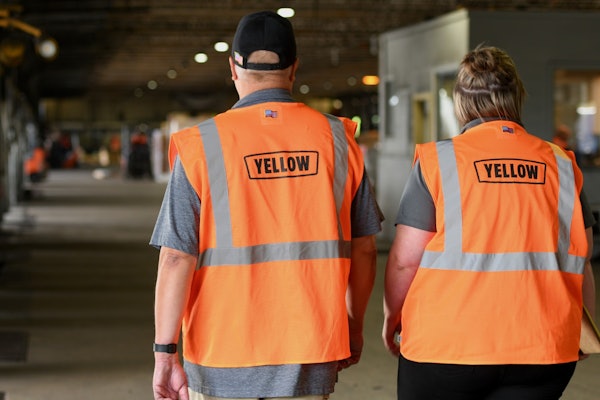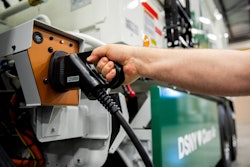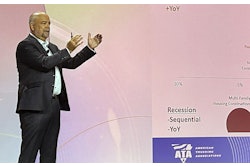Ozark Trucking takes plunge into electrification.
In Ed Gamache’s ideal world, there would be a plug everywhere his trucks go. There would be a row of electrical outlets in his Sacramento, Calif., parking lot, dozens of them at shipper docks and plugs at every truck stop and rest area along California’s highways. In an ideal world, Gamache, senior safety and maintenance manager at grocery hauler Ozark Trucking Co., would actually be making money on the two trucks he’s equipped with idling alternative systems.
As it stands now, the trucks are just breaking even. Still, Gamache plans to order seven additional trucks equipped with 600 pounds of extra batteries, inverter and electrically fired HVAC system so that some of his over-the-road drivers don’t have to idle. Why bother when it may take six years to see a return on investment?
“If there was no payback, but it didn’t cost me anything, I would still do it,” Gamache says. “I would do it because it’s good for the environment. There doesn’t have to be a payback.”
Gamache, who manages about 70 daycabs and 30 over-the-road sleeper-equipped trucks, may be an environmentalist at heart, but he also understands the business power of being out front on this issue in an environmentally sensitive state like California. The carrier and its parent company, Raley’s, a large grocery store chain that runs 65 trucks of its own, are community oriented and environmentally conscious. Equipping trucks with idling alternatives like shore power and battery packs as Ozark has done, or running eight zero-emission, liquid natural gas trucks as Raley’s does, returns public relations dividends. “A lot of the things we’re doing support that philosophy,” Gamache says.
But these steps also follow Ozark’s tradition of technology investments. “We’ve always been somewhat progressive,” Gamache says. “We had onboard computers before anyone else. We’ve tried to be current or helping lead the way in new technology.”
The technology helps the fleet achieve its goal of reducing idling across the board. And while the idling alternative technology in which Ozark Trucking has invested may not return huge financial dividends, it still has the potential to, says Bill Warf, a project manager for the Sacramento Municipal Utility District (SMUD), which is picking up half the tab on the equipment. Warf estimates a 75 percent reduction in idling time on Ozark’s two trucks.
“We documented the average idle time for seven of Ozark’s long-haul trucks, and they were averaging 1, 788 hours of idling per truck, per year,” says Warf, who first approached Ozark Trucking with the anti-idling proposal in early 2003. “With our idle-reduction technology, we should see a reduction of 1, 344 hours.”
As the price of a gallon of diesel climbs above $2 a gallon in California and heads for record territory nationally, the opportunity to save gets better and so does the return on investment. The federal government’s Argonne National Laboratory estimates an idling truck burns around one gallon an hour, which works out to $1.60 per hour at March’s national average diesel prices. The tally: around $2,150 per truck annually.
Ozark is realizing fuel savings much closer to $1,800 per truck per year, Gamache says. But much of those savings are siphoned off by the $6,500 cost of the extra equipment, even though SMUD, through a $200,000 U.S. Environmental Protection Agency SmartWay program grant, is paying half of it.
The system includes a Dometic air conditioner/heater unit, a Xantrex inverter/charger, a Phillips & Temro basic cab wiring kit and from one to three Lifeline VRLA batteries. Depending on the number of batteries, the system provides from 6 to 8 hours of idle-free operation. But Gamache doesn’t yet know how long the batteries at the base of the system will last. If those units have to be replaced – at nearly $300 each – the return of investment on the system might take as long as six years, which is Ozark Trucking’s typical trade cycle.
“This is a bridge technology,” Gamache says. “If there were plugs everywhere, we could do this with a smaller battery system and a small addition of weight. The system’s price drops down in the $3,000 range, and our battery replacement costs go away.”
Other barriers exist as well. Warf says the biggest hurdle to electrification – whether at truck stops or carrier yards – is tradition. Truckers think trucks are supposed to idle, says Warf, whose first job was as an engineer building Peterbilts. In the two years he has been involved with the anti-idling program at SMUD, Warf has found it difficult to win fleet participation. “Carriers don’t have much interest in shore power because there are no plugs where they go. It’s not what truckers do and carriers have to invest in equipment.”
“Whenever you talk about making changes, you have to remember the industry,” Gamache agrees. “The lights have to be on if the truck is parked, the truck can’t move unless the CB works and you have to idle it if you’re going to be a truck driver. That’s probably what they teach you in the first day of school at Western Truck Driving School.”
To counter that mentality in his own fleet, Gamache has included idle time as part of a complicated bonus formula. The more a trucker idles, the lower his bonus is – high idle time can eliminate bonuses altogether, meaning as much as $1, 500 in a year.
To entice fleets, however, the system must produce returns, says Warf. Today, he can offer fleets a grant-based supplement on the equipment, but ultimately a system has to earn money for the trucking company. “I’ve tried to show how this kind of a system can save money,” Warf says. “I think the reason that Ozark Trucking wants to add seven trucks instead of 30 is that we don’t really have a persuasive case yet that this system has an attractive payback. It’s a business decision.”
That decision may ultimately be easier to make as plug-in spots appear. SMUD will soon outfit Ozark Trucking’s parking lot with enough plugs for the new trucks, which Gamache is ordering, and the utility is approaching some of the grocer’s customers, hoping to add more spots. A local truck stop has a number of parking slots wired and reserved for shore power. Anti-idling regulations and additional grants are also spurring interest in idling alternatives, both in California and New York. If the trend continues, which is likely considering the cost of fuel and the EPA’s emphasis on idle-free corridors, some day in the not-too-distant future the anti-idling system Ozark and SMUD have developed could turn real dividends.
From a business standpoint, the opportunity is hard to ignore. While idling costs as much as $2.40 an hour in California, depending on the price of diesel, plugging in costs between 8 and 20 cents over the same period. If the infrastructure can be built, then more carriers will follow Ozark Trucking’s lead.





![Volvo Vnl Sleeper Review[20]](https://img.ccjdigital.com/mindful/rr/workspaces/default/uploads/2025/11/volvo-vnl-sleeper-review20.lrVppY9UDR.jpg?auto=format%2Ccompress&fit=crop&h=167&q=70&w=250)



